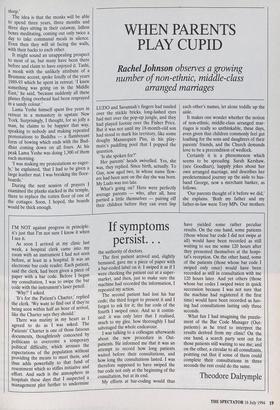If symptoms
persist. . .
I'M NOT against progress in principle: it's just that I'm not sure I know it when I see it.
As soon I arrived at my clinic last week, a hospital clerk came into my room with an instrument I had not seen before, at least in a hospital. It was an electronic bar code reader. Each patient, said the clerk, had been given a piece of paper with a bar code. Before I began my consultation, I was to swipe the bar code with the instrument's laser pencil.
'Why?' I asked. 'It's for the Patient's Charter,' replied the clerk. 'We want to find out if they're being seen within half an hour of arrival, like the Charter says they should.' There was mutiny in my heart as I agreed to do as I was asked. The Patients' Charter is one of those fatuous documents, thoughtlessly concocted by politicans to overcome a temporary political difficulty, which arouses the expectations of the population without providing the means to meet them, and thus adds powerfully to that fund of resentment which so stifles initiative and effort. And such is the atmosphere in hospitals these days that I suspected a management plot further to undermine the authority of doctors.
The first patient arrived and, slightly bemused, gave me a piece of paper with a bar-coded label on it. I swiped it as if I were checking the patient out at a super- market, and then, just to make sure the machine had recorded the information, I repeated my action. The second patient had lost his bar code; the third forgot to present it and I forgot to ask for it; the bar code of the fourth I swiped once. And so it contin- ued: it was only later that I realised, much to my glee, how thoroughly I had sabotaged the whole endeavour.
I was talking to a colleague afterwards about the new procedure in Out- patients. He informed me that it was an attempt to record how long patients waited before their consultations, and how long the consultations lasted. I was therefore supposed to have swiped the bar code not only at the beginning of the consultation, but at its end.
My efforts at bar-coding would thus have yielded some rather peculiar results. On the one hand, some patients (those whose bar code I did not swipe at all) would have been recorded as still waiting to see me some 120 hours after they presented themselves at the hospi- tal's reception. On the other hand, some of the patients (those whose bar code I swiped only once) would have been recorded as still in consultation with me 120 hours later. And yet others (those whose bar codes I swiped twice in quick succession because I was not sure that the machine had registered it the first time) would have been recorded as hav- ing had consultations lasting only three seconds.
What fun I had imagining the puzzle- ment of the Bar Code Manager (Out- patients) as he tried to interpret the results derived from my clinic! On the one hand, a search party sent out for those patients still waiting to see me; and on the other, a circular to all consultants, pointing out that if some of them could complete their consultations in three seconds the rest could do the same.
Theodore Dalrymple


















































 Previous page
Previous page